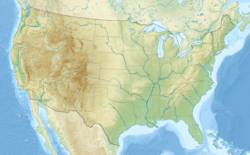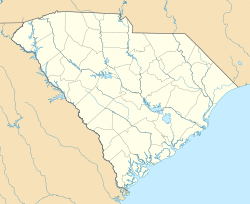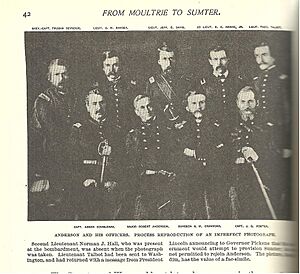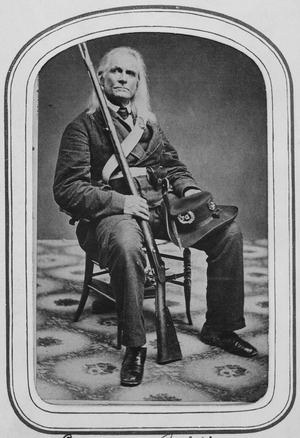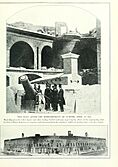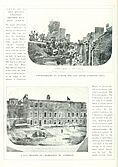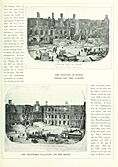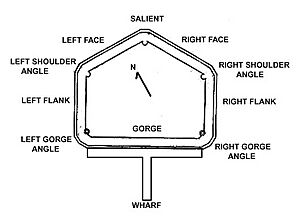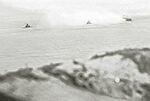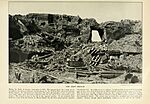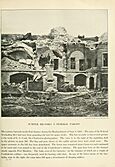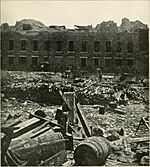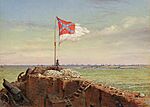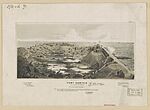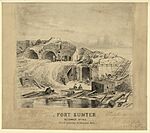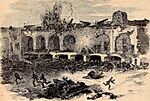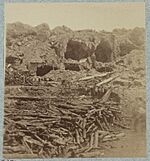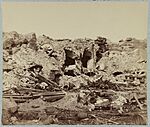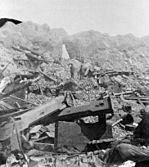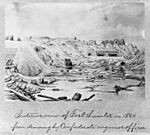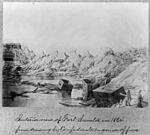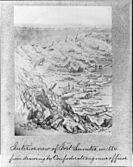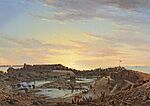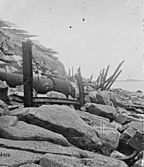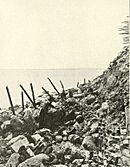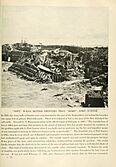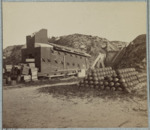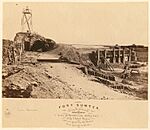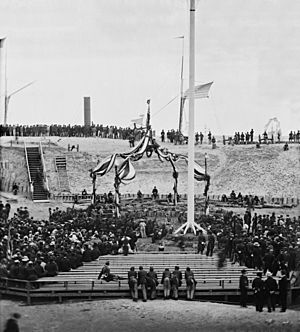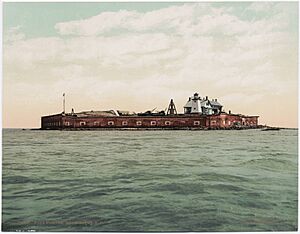Fort Sumter facts for kids
|
Fort Sumter
|
|
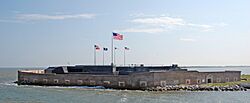
View from north in 2009
|
|
| Location | Charleston Harbor, South Carolina |
|---|---|
| Area | 234.74 acres (0.95 km2) |
| Built | 1829 |
| Visitation | 857,883 |
| Website | Fort Sumter and Fort Moultrie National Historical Park |
| NRHP reference No. | 66000101 |
Quick facts for kids Significant dates |
|
| Added to NRHP | October 15, 1966 |
| Designated HD | April 28, 1948 |
Fort Sumter is a famous sea fort near Charleston, South Carolina. It sits on an artificial island at the entrance of Charleston Harbor. Construction started in 1829. The fort was built after the War of 1812 to protect American coasts from naval attacks.
In 1861, Fort Sumter was still unfinished. It was attacked by Confederate soldiers on April 12, starting the American Civil War. The fort was badly damaged and left in ruins. After the war, some repairs were made, but it was never fully completed as planned. Today, Fort Sumter is a public park. It is part of the Fort Sumter and Fort Moultrie National Historical Park. The National Park Service takes care of it.
Contents
Fort Sumter's Story
Building a Strong Fort
Fort Sumter was named after Continental Army officer Thomas Sumter. It was ordered after the War of 1812. That war showed that America needed better defenses against ships. The fort was built near Charleston, South Carolina. It was part of a plan to protect American harbors.
The fort was built on an artificial island. This island was in the middle of Charleston's harbor channel. Fort Sumter was meant to control the harbor. It would work with other forts like Fort Moultrie to keep the area safe.
The artificial island began as a sand bar. In 1827, engineers checked the water depth. They decided it was a good spot for a fort. Building started in 1829. Workers brought 70,000 tons of granite from New England. This granite helped build up the island. By 1834, a timber base was laid underwater. Later, they decided to build a stronger brick fort.
The brick fort has five sides. It is about 170 to 190 feet (52 to 58 meters) long. Its walls are 5 feet (1.5 meters) thick. They stand 50 feet (15.2 meters) above low tide. The fort was designed to hold 650 men and 135 guns. These guns would be on three levels. However, it was never fully finished.
Construction took a long time. There were problems with land ownership. Also, it was hard to get enough money for such a big project. Bad weather and sickness made things even tougher. The outside of the fort was completed. But the inside and its weapons were not.
Who Owned the Fort?
In the early 1800s, South Carolina owned several forts. These included Fort Moultrie and Castle Pinckney. In 1805, the state gave these forts to the United States. The forts were not very useful and cost a lot to keep up. So, the state agreed to give them away.
Later, on December 17, 1836, South Carolina gave up all its claims. It officially gave the site of Fort Sumter to the United States.
Fort Sumter and the Civil War
The Start of the War
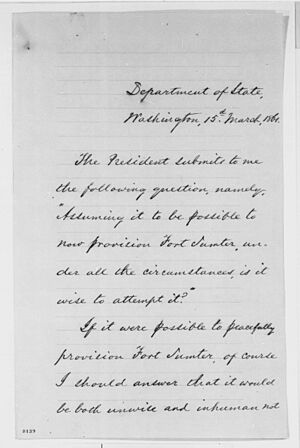
Fort Sumter is famous for two battles. The first battle started the American Civil War. It was one of many forts planned after the War of 1812. These forts had strong, tall walls made of heavy stone. Construction began in 1829. But the fort was not finished when the Civil War began in 1861.
The attack on Fort Sumter is seen as the start of the Civil War. People in Charleston celebrated at the time. The First Battle of Fort Sumter began on April 12, 1861. South Carolina soldiers fired cannons from the shore. They fired at the Union soldiers inside the fort. Both sides agreed these were the first shots of the war.
The bombing lasted all day. Many happy civilians watched. The fort's supplies were cut off. It surrendered the next day. Major Robert Anderson took the American flag with him. Then, his soldiers left the fort.
The Second Battle of Fort Sumter happened on September 8, 1863. The Union tried to take back the fort. But they failed because army and navy leaders disagreed. The fort was turned into rubble. Yet, it stayed in Confederate hands. It was finally left empty in February 1865. This happened when General Sherman marched through South Carolina.
A big "End of the War" party happened at Fort Sumter. It was on April 14, 1865. Major General Anderson, though sick, came back. He raised the flag over the fort again. But that evening, President Lincoln was assassinated. This sad news quickly overshadowed the celebration.
Getting Ready for Battle
On December 26, 1860, South Carolina left the Union. Six days later, U.S. Army Major Robert Anderson moved his soldiers. He left Fort Moultrie because it was hard to defend. He secretly moved 127 men to Fort Sumter. He did this without orders from his leaders.
Anderson thought a stronger defense would stop an attack. Fort Sumter was not yet complete. Less than half of its cannons were in place. This was because President James Buchanan had cut military spending.
On January 31, 1861, South Carolina Governor Pickens sent a letter. He demanded that President Buchanan give up Fort Sumter. He said its possession was "not consistent with the dignity or safety of the State." For months, calls to leave Fort Sumter were ignored. These calls came from South Carolina and then from Confederate General P. G. T. Beauregard.
Union attempts to send supplies and more soldiers failed. On January 9, 1861, shots were fired. Cadets from the Citadel stopped the ship Star of the West. This ship was trying to bring troops and supplies to Fort Sumter.
President Abraham Lincoln learned that Anderson's men would run out of food. This would happen by April 15, 1861. So, Lincoln ordered a group of ships to help. This fleet, led by Gustavus V. Fox, tried to enter Charleston Harbor. The ships carried soldiers and supplies. By April 6, 1861, the first ships sailed to Charleston. The Harriet Lane arrived on April 11, 1861.
The First Battle of Fort Sumter
On April 11, 1861, Confederate aides asked Anderson to surrender. Anderson refused. The aides reported back to General Beauregard. After talking to the Confederate Secretary of War, Beauregard sent the aides back. He told them to decide if the fort should be taken by force. The aides waited for hours while Anderson thought.
Around 3:00 a.m., Anderson gave his conditions. Colonel Chesnut, one of the aides, decided they were not good enough. The aides then left the fort. They went to nearby Fort Johnson. There, Chesnut ordered his men to fire on Fort Sumter.
On April 12, 1861, at 4:30 a.m., Confederate cannons opened fire. They fired for 34 hours straight. Edmund Ruffin, a famous Virginian, claimed he fired the first shot. But Lieutenant Henry S. Farley actually fired it at 4:30 a.m. The Union soldiers did not fire back for over two hours.
The fort's ammunition was not right for the job. They had no fuses for explosive shells. This meant their shells could not explode. Only solid iron balls could be used. Around 7:00 a.m., Captain Abner Doubleday fired the Union's first shot. He missed. Major Anderson did not use the highest guns. These guns could have hit the Confederates better. But the gunners would have been more exposed.
The firing continued all day. The Union fired slowly to save ammunition. At night, the fort stopped firing. But the Confederates still sent shells into Sumter. On April 13, the fort surrendered and was emptied. During the attack, the Union flag fell. Lieutenant Norman J. Hall bravely put it back up. He burned his eyebrows doing it.
One Confederate soldier died from a misfiring cannon. One Union soldier died and another was badly hurt. This happened during a 100-shot salute allowed by the Confederacy. The salute was then shortened to 50 shots. People in Charleston watched from balconies. They drank toasts to the start of the fighting.
-
Panoramic View of Left shoulder Angle at left with a second Hot Shot furnace and Left face at right; Fort Sumter 1861; flying the Confederate Flag
The Fort Sumter Flag became a symbol of patriotism. Major Anderson took it North with him. The Star of the West took all the soldiers to New York City. They were welcomed with a parade on Broadway.
Union Attacks on Fort Sumter
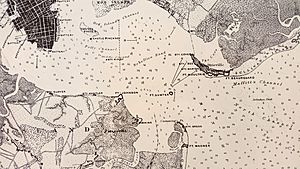
Union forces tried to take back Charleston Harbor on April 7, 1863. Rear Admiral Samuel Francis Du Pont led the attack. He commanded several ironclad ships. These included the New Ironsides and several monitors. They attacked the harbor's defenses.
The attack failed. The Union's best ship, New Ironsides, did not fight well. The ironclads fired only 154 shots. The Confederates fired 2,209 shots back. The USS Keokuk was damaged and sank the next day. Over the next month, Confederates saved two large guns from the Keokuk. One of these guns was put in Fort Sumter.
Meanwhile, the Confederates made Fort Sumter stronger. Almost 500 enslaved African people worked under army engineers. They filled rooms with sand. They protected walls with sandbags. They built new shelters. Some of Fort Sumter's guns had been moved. But 40 cannons were still there. The heaviest guns were on the highest level. This gave them a wide view. But it also made them more open to enemy fire.
A special medal, the Gillmore Medal, was given later. It honored Union soldiers who served at Fort Sumter. They served under Major-General Quincy Adams Gillmore.
After heavy bombing, Major General Quincy A. Gillmore and Rear Admiral John A. Dahlgren planned a boat attack. They wanted to attack Fort Sumter on the night of September 8–9, 1863. But the Army and Navy did not work well together. Dahlgren refused to let his sailors be led by an army officer. So, two groups of boats headed for Fort Sumter that night.
The army's boats were delayed by low tide. By the time they could move, the navy's attack had already failed. So, the army boats went back to shore.
The Navy's attack involved 400 sailors and Marines in 25 boats. The whole operation was a mess. There was poor scouting, planning, and communication. Commander Thomas H. Stevens, Jr. was in charge. He said he "knew nothing of [the attack's] organization." Dahlgren replied that there were "nothing but a corporal's guard" in the fort. He thought it would be easy to take. This underestimation might explain why he wanted the navy to get all the credit.
Less than half of the boats landed. Most that did land were on the wrong side of the fort. The Union sailors and Marines could not climb the wall. Confederates fired at them. They also threw hand grenades and loose bricks. The men in the boats that had not landed fired blindly. They endangered their own landing party more than the enemy. The landing party hid in holes in the wall.
A signal rocket from the fort brought more Confederate fire. Fort Johnson and the warship CSS Chicora fired on the boats. Many boats left under fire. The landing party surrendered. The Union lost 8 killed, 19 wounded, and 105 captured. The Confederates had no casualties.
After the failed boat attack, the bombing started again. It continued with different levels of force. This caused more damage to Fort Sumter until the war ended. The soldiers inside kept getting hurt. Confederates kept saving guns and materials from the ruins. They also bothered Union soldiers on Morris Island with sharpshooters. The Confederates placed more cannons in the fort's lower levels.
Fort Sumter is Taken Back
The last Confederate commander, Major Thomas A. Huguenin, never surrendered Fort Sumter. But General William Tecumseh Sherman's march through South Carolina changed things. It forced the Confederates to leave Charleston on February 17, 1865. They also abandoned Fort Sumter. The U.S. government officially took over Fort Sumter on February 22, 1865.
Anderson, now a major general, returned to Sumter. He brought the flag he had been forced to lower four years earlier. On April 14, 1865, he raised it in victory over the ruined fort. Henry Ward Beecher was there and spoke about the event.
After the War: A New Purpose
When the Civil War ended, Fort Sumter was a wreck. The U.S. Army worked to make it useful again. The damaged walls were made lower and partly rebuilt. The top level of gun placements was removed. Eleven of the original lower-level gun rooms were fixed. They were armed with 100-pounder Parrott rifles.
From 1876 to 1897, Fort Sumter was just an unmanned lighthouse station. The start of the Spanish–American War made people interested in its military use again. So, reconstruction began on the fort, which had fallen apart more over time. A new, large concrete blockhouse was built inside the old walls in 1898. It had two large 12-inch guns. This battery was named "Battery Huger." It was named after Revolutionary War General Isaac Huger. It never saw combat.
Battery Huger was shut down in 1947. In 1948, the fort became Fort Sumter National Monument. The National Park Service took control of it.
Many years later, a rolled-up telegram was found. It was in a trunk belonging to Colonel Alexander Ramsay Thompson. The telegram was from April 14, 1861. It was from the Governor of South Carolina. It said:
Fort Sumter surrendered yesterday after we had set all on fire... F.W. Pickens
This message was given to a museum in Charleston.
In 1966, the site was added to the National Register of Historic Places. The Civil War Trust has helped save some land around Fort Sumter.
Visiting Fort Sumter and Fort Moultrie National Historical Park
Fort Sumter and Fort Moultrie National Historical Park includes three places in Charleston. These are the original Fort Sumter, the Visitor Education Center, and Fort Moultrie. To get to Fort Sumter, you take a 30-minute ferry ride. You can catch the ferry from the Visitor Education Center or Patriots Point. Private boats are not allowed to access the fort anymore.
The Visitor Education Center has a museum. It shows exhibits about the disagreements that led to the Civil War. The museum at Fort Sumter focuses on the fort's history. This includes how it was built and its role in the Civil War.
April 12, 2011, was the 150th Anniversary of the Civil War's start. Thousands of Civil War reenactors gathered to remember the events. A United States stamp of Fort Sumter was also issued that day.
In August 2015, flagpoles at Fort Sumter were removed. This was to create a new exhibit. The four historic national flags now fly on the lower parade ground.
By December 2019, sea level rise caused changes at the park. The Park Service moved large rocks farther from the fort's walls. This created a protective breakwater and wetland. These rocks were originally placed to protect the fort from the sea.
Interesting Facts about Fort Sumter
- The War of 1812 showed that a fort like Fort Sumter was needed.
- The fort was named after General Thomas Sumter. He fought in the French and Indian War and the Revolutionary War.
- Building the fort was stopped for seven years. This was because there were questions about who owned the land where the fort was being built.
- Fort Sumter was not fully finished when the Civil War started.
- No soldiers were killed in the main attack on Fort Sumter in 1861.
- However, one Union soldier, Private Daniel Hough, was killed by accident. This happened during a ceremony as the Union Flag was being lowered.
- The Union got control of the fort again on April 14, 1865. They raised their flag over the fort on that day. This was exactly four years after the flag was lowered in 1861. It was also the same day that Abraham Lincoln was shot at Ford's Theater.
See also
 In Spanish: Fort Sumter para niños
In Spanish: Fort Sumter para niños


